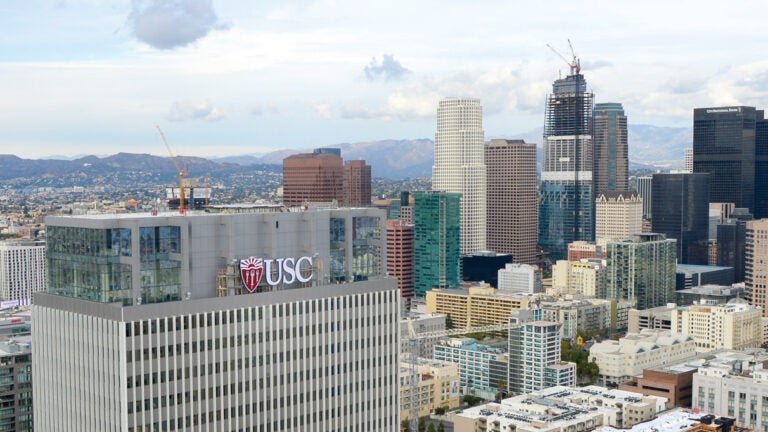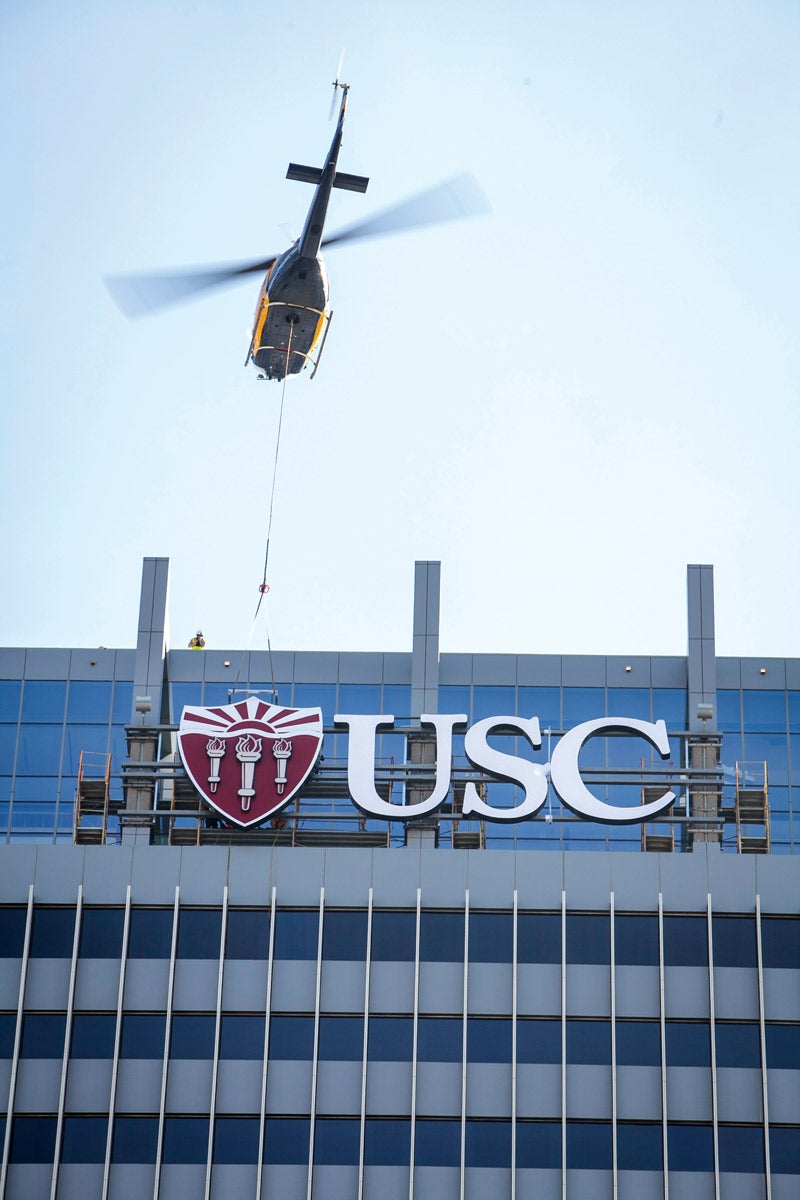
PHOTO BY GUS RUELAS
Trojans and the City
Trojans are behind some of the high-profile developments in downtown Los Angeles.
The helicopter gently rises toward the roof of the office tower in downtown Los Angeles, its rotors emitting a steady taka-taka-taka-taka.
Beneath it, a 500-pound white letter “U” dangles and sways in the wind. It rises ever higher as the pilot carefully guides the letter—taller than an elephant—next to the “SC” already installed on the building’s front. With the new signage, it’s official: USC is now the majority tenant in a landmark, 32-story building on the northeast corner of Olive and 12th streets.
The move is just the latest, and maybe most visible, sign of USC’s longstanding influence in the rapidly developing area of South Park.

“USC’s presence is definitely felt—it’s a part of downtown and a critical part in ensuring downtown’s viability,” says Jessica Lall ’06, executive director at South Park Business Improvement District, which promotes the neighborhood and facilitates streetscape projects and community programs. Lall has been involved in downtown LA development for six years and was a featured speaker at a USC Alumni Real Estate Network panel on Los Angeles growth last fall. She is one of the many Trojans working through Pacific Rim-based development companies to transform downtown LA.
When Sonnet Hui ’00 arrived in Los Angeles from Hong Kong as an international student in the 90s, she moved from a vibrant metropolis to what she describes as a ghost town, she says. “LA was different: The city was a sprawling suburbia from a newcomer’s point of view, disjointed with no heart or real center,” says Hui, an executive project director at Hazens Group USA, a Chinese development company.
Since then, Staples Center, LA Live and the Ritz-Carlton have sprouted in the South Park neighborhood. A supermarket and a Los Angeles Unified School District charter elementary school soon followed.
Today, more than a dozen developments are in the works—many of them helmed by USC alumni—as South Park’s landscape transforms. “South Park is a community within a community. We have the California Hospital Medical Center, Eisner Pediatric and Family Medical Center and the Mayan and Belasco theaters. We also have the fastest-growing residential population in downtown,” Lall says. More than 6,800 people live in the neighborhood, but Lall estimates that number will triple by 2018.
One of the new developments is the Hazens LA Center on Figueroa Street, a mixed-use project headed by Hui that will feature a 30-story hotel, two condo towers and 80,000 square feet of retail space.
“In three to five years, South Park will be a very different place, and it has the potential of becoming LA’s new city center,” Hui says.
Downtown LA is quickly becoming the urban center that it was always meant to be.
Ryan Aubry, development manager at Greenland USA
On South Park’s northern edge rises the Wilshire Grand Center. The building is owned by Korean Air (whose CEO and chairman is USC Trustee Y.H. Cho MBA ’79), and at 1,100 feet, it will be LA’s tallest building when it’s completed next year. The architectural firm behind it, AC Martin, already created many of downtown’s iconic buildings, including the art deco-inspired City Hall and the Spanish Baroque Revival-style Million Dollar Theatre.
“AC Martin’s architectural legacy in downtown LA extends beyond a century of time,” says Tammy Jow ’95, project director at AC Martin. “The challenge with the Wilshire Grand was to create a building of our time—a contemporary contrast to a generation of flat-top buildings composed of granite and inset windows.”
Developers are also mindful about the impact on the local community. “As Los Angeles grows, there is a greater necessity to design connections to each other and develop opportunity in a way that engages communities to decide what they want to become,” Hui says.
Along those lines, the South Park Business Improvement District oversees a curated public art program and has repaired more than 800 sidewalks. It also launched its pilot Green Alley Project to transform unused alleys into public gathering spaces. In April, work began on The Spot @ Hope Street, a 33-foot-wide park that spans half a block in the middle of Hope Street.
“Downtown LA is quickly becoming the urban center that it was always meant to be,” says Ryan Aubry MRED ’07, development manager at Greenland USA. Two years ago, Greenland USA invested more than $1 billion to convert a 6-acre South Park plot into a residential and retail space named Metropolis. Metropolis includes Avenue of Angels, a four-block pedestrian stretch that will link the financial district to the sports and entertainment district and the convention center.
“As the revitalization continues, the links between downtown and neighboring communities will only get stronger,” Aubry says. “This is very apparent when it comes to USC’s University Park Campus to the south, and the Health Sciences Campus to the northeast. In the past, students and faculty on these campuses may have dismissed the thought of living in downtown; now it has become one of the best options.”
